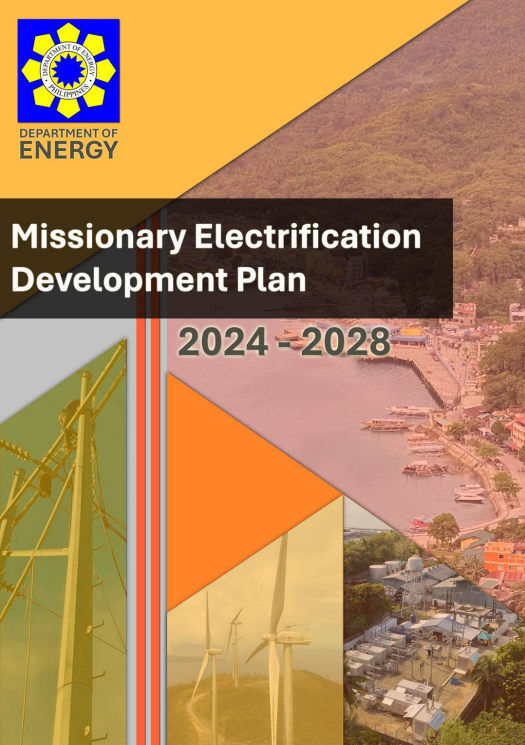EXECUTIVE SUMMARY

The 2024–2028 Missionary Electrification Development Plan (MEDP) is the Philippine government’s strategic roadmap for achieving universal, sustainable, and inclusive energy access in off-grid and underserved areas. Aligned with the Philippine Energy Plan (PEP) 2023–2050, the MEDP integrates modernization, renewable energy deployment, private sector participation, and grid interconnection to bridge energy gaps and accelerate electrification nationwide.
- The plan defines missionary electrification in Chapter 1, emphasizing its role in providing long-term, viable electricity services to remote communities through both government-led programs and private-sector engagement. It also highlights the crucial roles of the DOE, National Electrification Administration (NEA), National Power Corporation (NPC), and Distribution Utilities (DUs) in ensuring efficient and sustainable electrification initiatives.
- Chapter 2 presents a comprehensive electrification assessment, acknowledging both progress and persistent challenges. While power access has expanded, many isolated communities still struggle with unreliable electricity due to financial constraints, logistical difficulties, outdated infrastructure, and regulatory barriers. Addressing these challenges is critical to accelerating electrification efforts and ensuring equitable energy access for all.
- To overcome these barriers, Chapter 3 introduces key policies and strategic programs under the Off-Grid Development Roadmap, detailing short-, medium-, and long-term solutions. Renewable energy integration plays a central role, with hybrid power systems combining solar, wind, hydro, and battery storage with conventional diesel generation to reduce costs and carbon emissions. The expansion of microgrids and mini-grids is a priority to provide decentralized energy solutions for greater reliability and efficiency. Major grid interconnection projects, including the Batangas–Mindoro and Palawan– Mindoro Interconnection Projects, are also advancing to enhance regional energy security. Additionally, the rationalization of the Universal Charge for Missionary Electrification (UC-ME) aims to enhance efficiency in power generation and consumption and establish a more sustainable financial model that attracts private investments while gradually reducing reliance on government subsidies.
- Chapter 4 outlines the power infrastructure expansion plans for 2024–2028, which include the development of new diesel and hybrid power plants to strengthen energy supply in underserved areas. Renewable energy deployment will be accelerated through the expansion of solar photovoltaic (PV) systems and battery storage technologies. Transmission and distribution system upgrades in the island grids of Palawan, Masbate, Catanduanes, Marinduque, and Mindoro will enhance grid reliability and ensure power quality to support growing energy demands.
- Ensuring the financial sustainability of missionary electrification is a core focus of Chapter 5. The DOE aims to optimize financing mechanisms by increasing private sector 2024-2028 Missionary Electrification Development Plan participation in electrification projects, promoting short-term interim lease agreements for generating units, and expanding the Photovoltaic Mainstreaming (PVM) initiative, which targets indigenous and unserved communities. The plan also aligns with the National Total Electrification Roadmap (NTER) to achieve full nationwide electrification by 2028.
- Modernization is a key pillar of Chapter 6, emphasizing the adoption of smart grids, digital energy management, and microgrid system enhancements. These initiatives will improve operational efficiency, reduce system losses, and enable a seamless transition to renewable energy solutions. The DOE’s strategy prioritizes sustainability, cost-effectiveness, and resilience, ensuring that off-grid communities receive affordable and uninterrupted electricity services.
- The 2024–2028 MEDP is more than just an electrification plan; it is a transformative blueprint for economic development and social progress. By bridging the energy access gap, it empowers communities, fosters local enterprise growth, enhances public services, and improves overall quality of life. To realize this vision, policymakers are encouraged to streamline project approvals, strengthen private-sector collaboration, and prioritize infrastructure investments. With aligned policies, strategic financing, and innovative renewable energy solutions, the DOE remains steadfast in its commitment to delivering universal, clean, and reliable energy access, ensuring that no Filipino is left behind in the nation’s journey toward progress and prosperity.
Click to view/download the PDF file of the Missionary Electrification Development Plan 2024-2028
